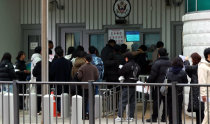[Editorial] Reference Point Accuracy
[Editorial] Reference Point Accuracy
Posted April. 21, 2006 02:59,
The National Geographic Information Institute (NGII) of the Ministry of Construction and Transportation (MOCT) manages reference points, such as benchmarks and triangular points of Korea. The Board of Audit and Inspection pointed out that the numbers were faulty. Benchmarks are markings that tell the elevation of land at certain points. These benchmarks were set up at some 6,000 points in Korea, but 60% of them cannot be located and many of the remaining are wrong. The government had originally planned to build Gageo Bridge connecting Busan and Geoje, using these benchmarks, but there was a one-meter height difference between the benchmarks and reality. It is a scary story.
Triangular points, which tell the latitude and longitude of certain places in Korea, are similarly faulty. According to the NGIIs measurements, Galmal-myeon in Gangwon Province is in the Mediterranean, Icheon of Gyeonggi Province is in the Yellow Sea, and Hwajeong-myeon in Yeosu, South Jeolla Province is at the equator.
The NGII has stated that it has used Global Navigation Satellite System (GNSS) to recalculate and correct benchmarks and triangular points at 22,000 places in Korea. But looking at the current results, it makes one wonder exactly what it has done during that time with 29.7 billion won of tax money at their disposal. If large-scale construction projects are carried out with faulty reference points, they are bound to be weak and wasteful.
Likewise, the governments statistical errors can lead to errant policies. The MOCTs survey of homeowners stated that there are 12.52 million in Korea, while the Ministry of Government Administration and Home Affairs (MOGAHA) says 16.73 million, and the Bank of Korea puts the number at 15.3 million. Since the government utilizes these errant statistics, which have a difference of up to 4.21 million, to make housing and financial policies, how can the policies be legitimate and appropriate?
The governments calculations of tax income have never been even remotely close, so being wrong actually has become the norm. The Minster of Labor had to apologize for announcing the wrong number of irregular workers in Korea. MOGAHA exaggerated numbers by adding babies in their calculations and announcing, The top 1% of the total population owns 51% of the land. The National Statistical Office pointed out the exaggerations.
It is worrying and becoming difficult to trust the government, with its faulty national reference points and continued statistical errors. The country should be managed with accurate numbers and statistics, or becoming an advanced nation will become a distant dream.




![화장실 갇혔을 때 생존법…“최후에는 변기뚜껑” [알쓸톡]](https://dimg.donga.com/c/138/175/90/1/wps/NEWS/IMAGE/2025/12/26/133042007.3.png)


